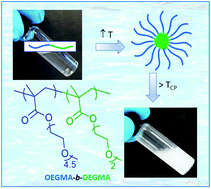Thermoresponsive oligo(ethylene glycol) methyl ether methacrylate based copolymers: composition and comonomer effect†
Abstract
Thermoresponsive polymers based on oligo(ethylene glycol) (OEG) methyl ether methacrylate monomers have drawn much attention in recent years. In this investigation, copolymers based on oligo(ethylene glycol) methyl ether methacrylate (OEGMA, 300 g mol−1) and di(ethylene glycol) methyl ether methacrylate (DEGMA) or/and n-butyl methacrylate (n-BuMA) were successfully synthesised via group transfer polymerisation (GTP). The experimental molar mass was around 10 000 g mol−1, while the OEGMA content was varied from 80% w/w to 50% w/w. Three different structures, including diblock bipolymer, diblock terpolymer and statistical copolymers, were synthesised and compared. The thermoresponsive properties of the copolymers were investigated in deionised water and phosphate buffered saline (PBS), and in aqueous mixtures with Pluronic® F127. Interestingly, while the diblock polymers solutions based on OEGMA and DEGMA were not able to form gels upon heating, these polymers were found to lower the critical gelation concentration (CGC) of Pluronic® F127 from 15% w/w to 10% w/w and increase the gelation temperature from room temperature to near body temperature.



 Please wait while we load your content...
Please wait while we load your content...